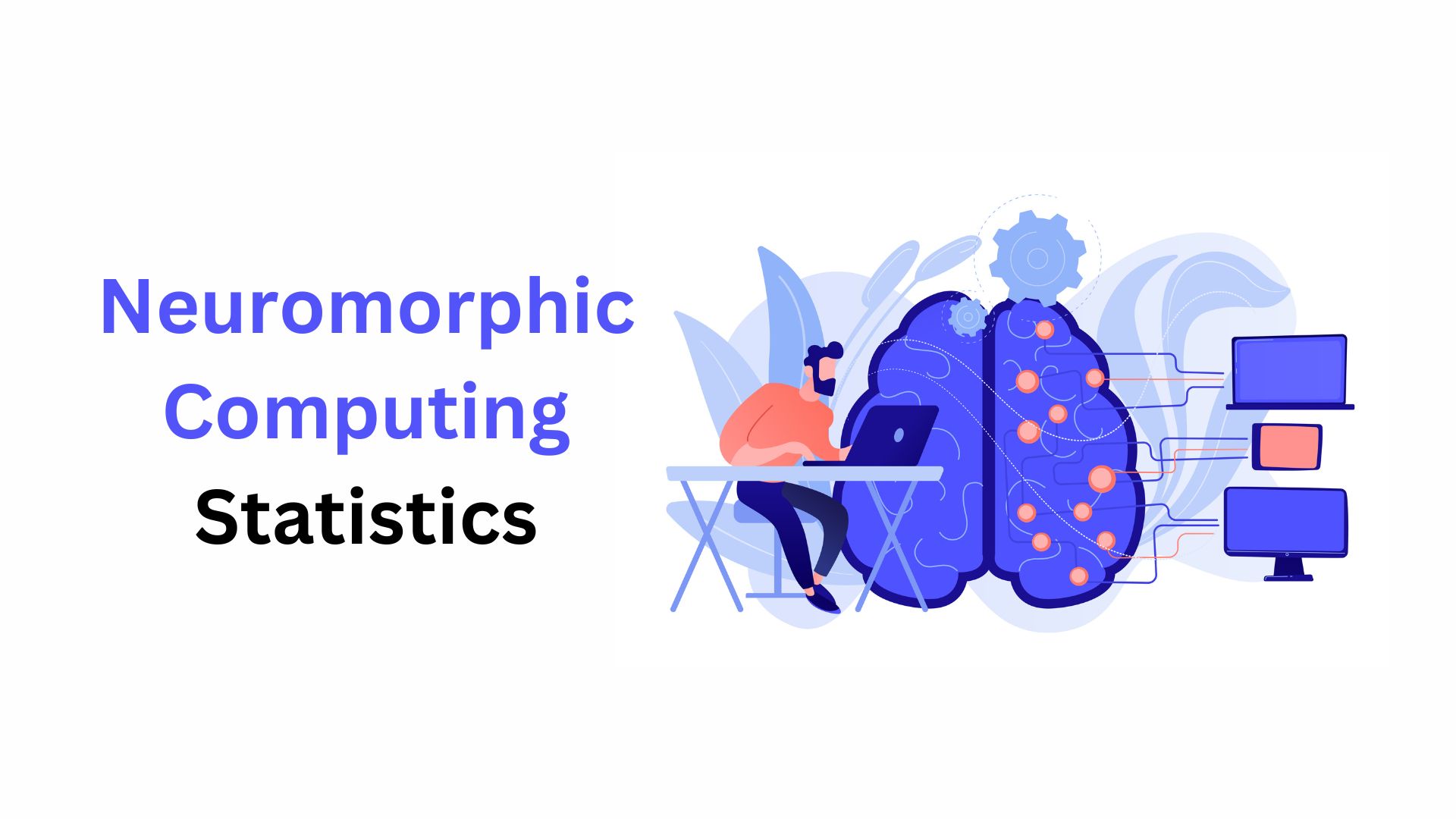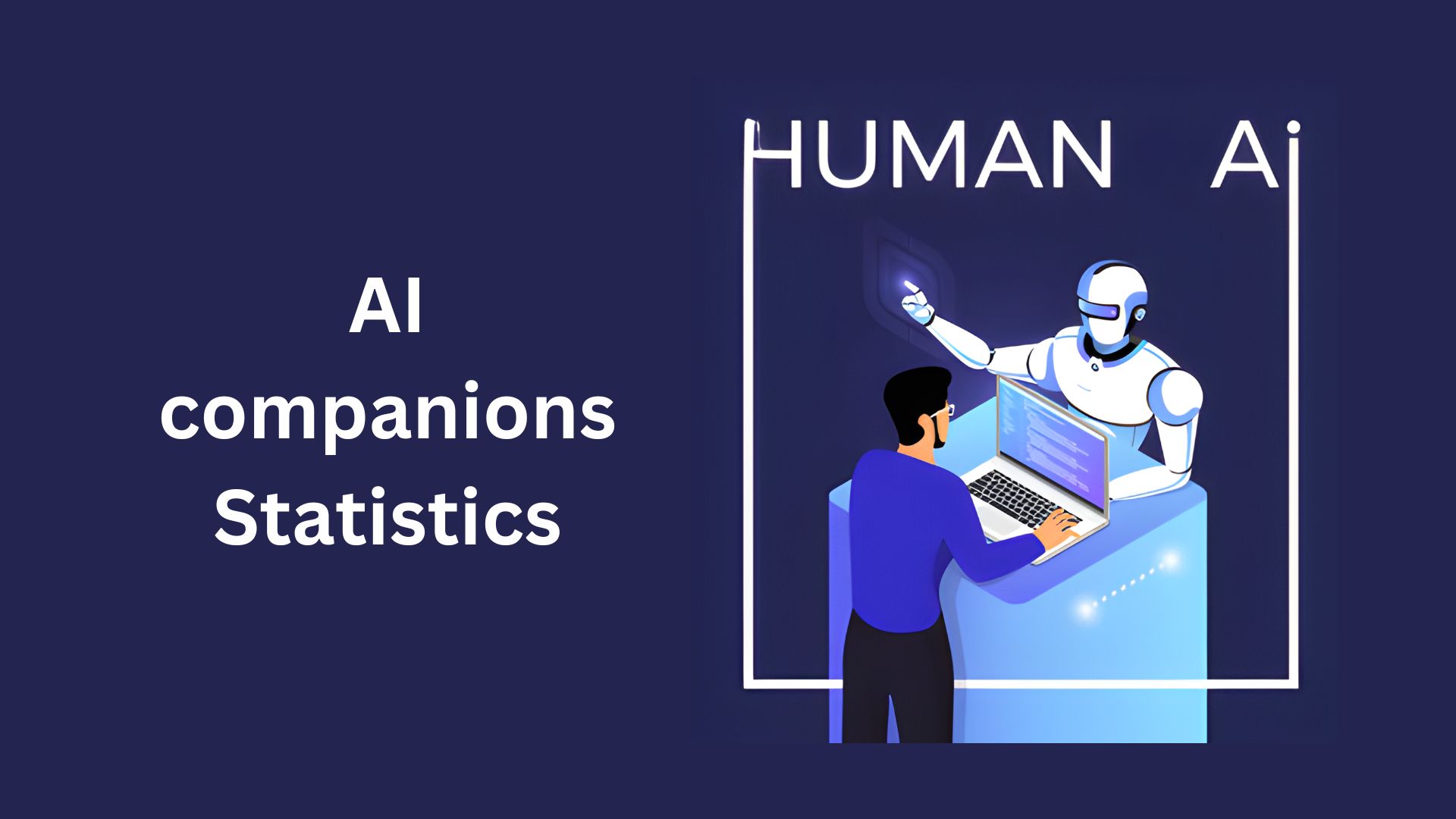AI Customer Service Statistics By Market Size, Region And Facts (2025)
Updated · Jul 25, 2025
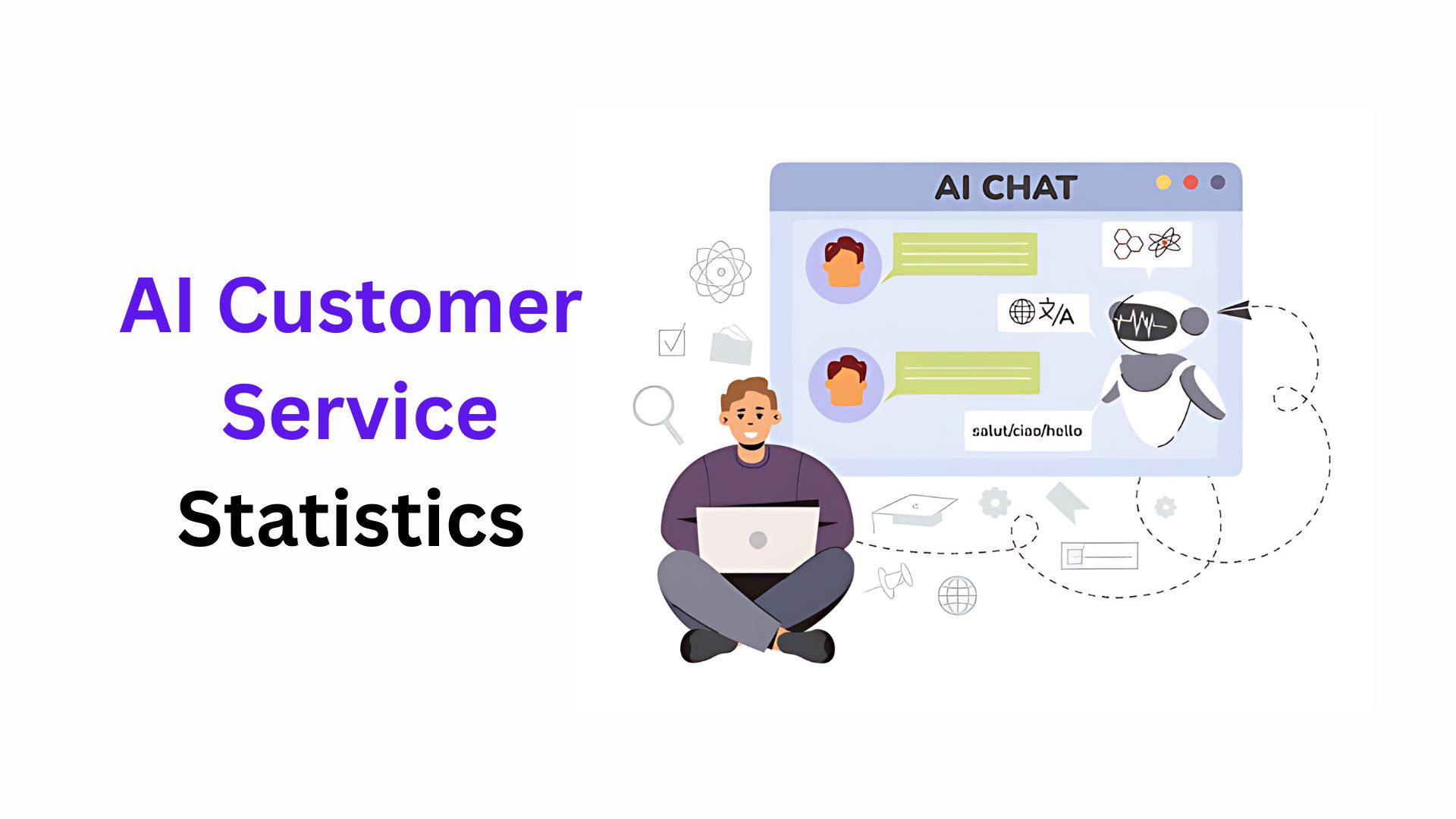
Table of Contents
- Introduction
- Editor’s Choice
- AI Customer Service Market Size
- AI Customer Service By Region
- Worldwide Contact Centre and Conversational AI Spending
- Most Common Ways To Use AI In Customer Service
- Benefits Of AI Customer Services
- Role of AI In Personalising Customer Experiences
- AI Improves Customer Service Efficiency And Productivity
- AI Customer Service Statistics Across Industries
- Business Leaders’ Support For AI In Customer Service
- Customer Perceptions And Trust In AI-Powered Customer Service
- Customer Opinion On AI Agents
- Impact of AI-Based Applications In Contact Centres
- Concerns And Challenges Of Using AI In Customer Service
- Future Use of AI In Customer Service
- Conclusion
Introduction
AI Customer Service Statistics: Customer service, which was once believed to be a handicraft, is fast becoming mechanized by AI. In 2024, businesses will use artificial intelligence not only to tackle customer queries but also to predict their needs, shorten wait times, and make all-time customer support possible. From chatbots to voice assistants, AI helps reduce operational costs while increasing customer satisfaction.
This automation wave is rising rapidly due to AI-assisted tools such as ChatGPT, Salesforce Einstein, and Zendesk AI. The article reviews the latest AI customer service statistics, providing insights for business owners, marketers, and support teams.
Editor’s Choice
- The AI customer service market is expected to increase from US$308.4 million in 2022 to US$2.89 billion by 2032.
- With a 48% share, North America leads the market, followed by Europe (29%) and Asia Pacific (20%).
- By 2024, US$23.17 billion will be poured into conversational AI by global contact centres, as opposed to US$16.08 billion in 2022.
- 89% of contact centres use AI chatbots, while 81% supposedly use AI for internal training and gathering performance insights.
- Support teams assert that the biggest benefits of AI are 24/7 availability (50%), time saved (45%), and faster resolution of issues (44%).
- Artificial intelligence use has resulted in a 37% shorter first response time and a 52% quicker ticket resolution time; some organisations have recorded upwards of US$1 million in savings attributed to the reduction of support tickets.
- Businesses using AI saw a 35% decrease in customer service costs and a 32% increase in revenues; ROI stands at US$3.50 for each US$1 spent.
- In retail, 63% of companies employ AI in assisting customers, 40% have set departments and budgets for this.
- In finance, 79.5% of the institutions plan to increase investments in AI; in 2023, 35 billion was invested and are forecasted to hit 97 billion in 2027.
- 70% of patients in the healthcare sector acknowledged that AI will change healthcare delivery, and 75% of top-tier healthcare organisations are going through the adoption of generative AI.
- Approximately 97% of telecom providers reported increased satisfaction from AI implementation; telecom operating costs see a reduction of as much as 30% attributable to AI.
- 91% of respondents said they were satisfied with AI in contact centres, attributing satisfaction to click-to-service, from shortened waiting times to an efficient cost-saving process.
- 77% of CX leaders believe AI bots can better engage with customers on an emotional level.
- 51% of consumers choose bots for instant service, but 90% still like human agents.
- Only 18% of consumers have confidence in discerning AI in interaction, including telemarketing, in the present-day markets.
- According to Gartner, AI has great potential and can save US$80 billion in call centre labour costs by 2026.
- 84% of CX leaders feel that human agents will have to be retrained to work alongside AI.
AI Customer Service Market Size
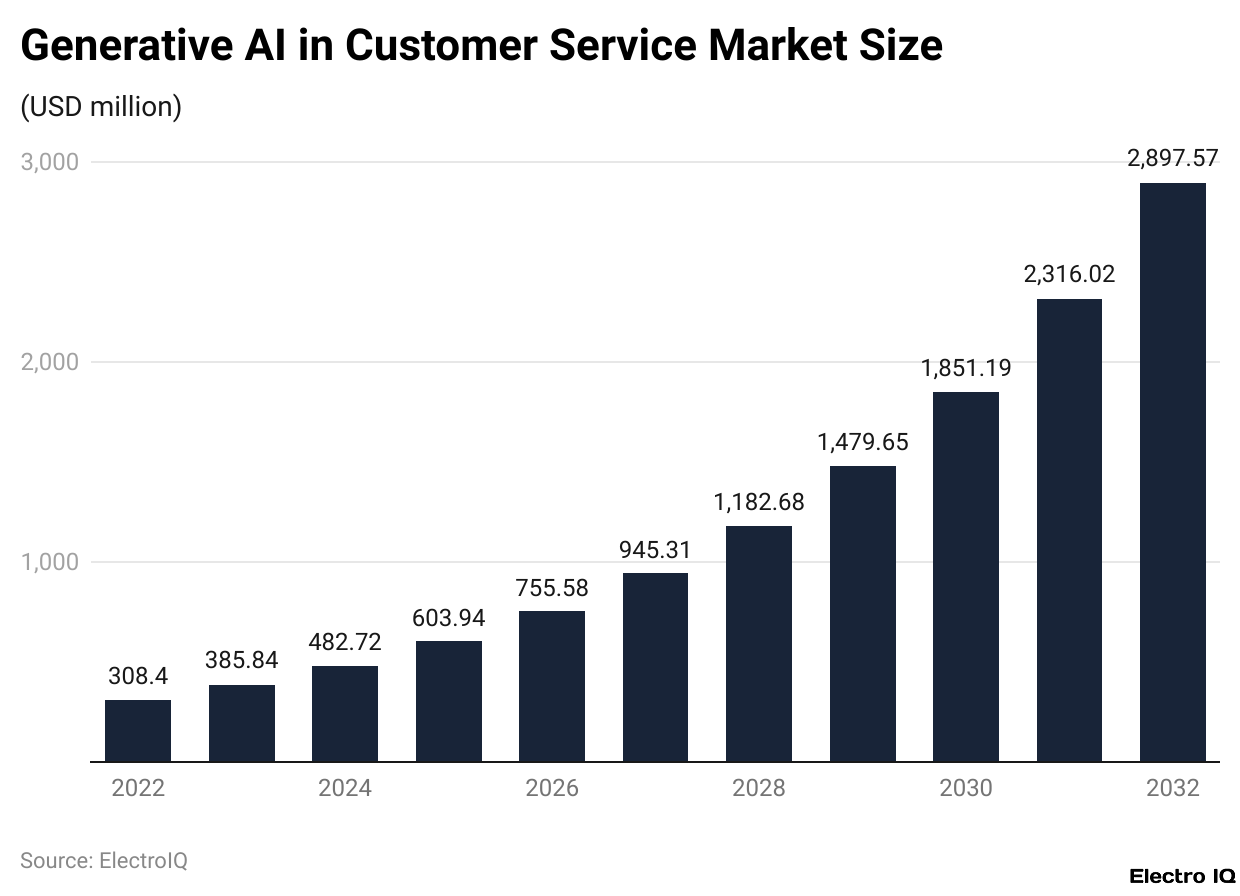
(Reference: tidio.com)
- As per Tidio, AI customer service statistics show that the generative AI market for customer service has been experiencing rapid and consistent growth.
- In 2022, the market was valued at US$308.4 million, and by 2023, it experienced a sudden increase, rising to US$385.84 million, with more and more companies adopting it to enhance support efficiency.
- Continuing its strong upward trajectory, 2024 will likely see a market size valuation of US$482.72 million.
- The market is forecasted to grow even further at a leading pace from 2025 onwards.
- In 2025, it is expected to reach US$603.94 million, followed by US$755.58 million in 2026.
- Onwards to 2027, the momentum continues with an anticipated value of US$945.31 million, and it will cross the billion-dollar milestone by 2028, scaling up to US$1.18 billion.
- Since the trajectory of growth knows no halt, market projections for 2031 stand at US$2.32 billion, and by 2032, the generative AI market in customer services is expected to be worth US$2.89 billion.
- Such exponential growth accounts for the extreme importance that generative AI will have in building the next-generation customer engagement paradigm.
AI Customer Service By Region
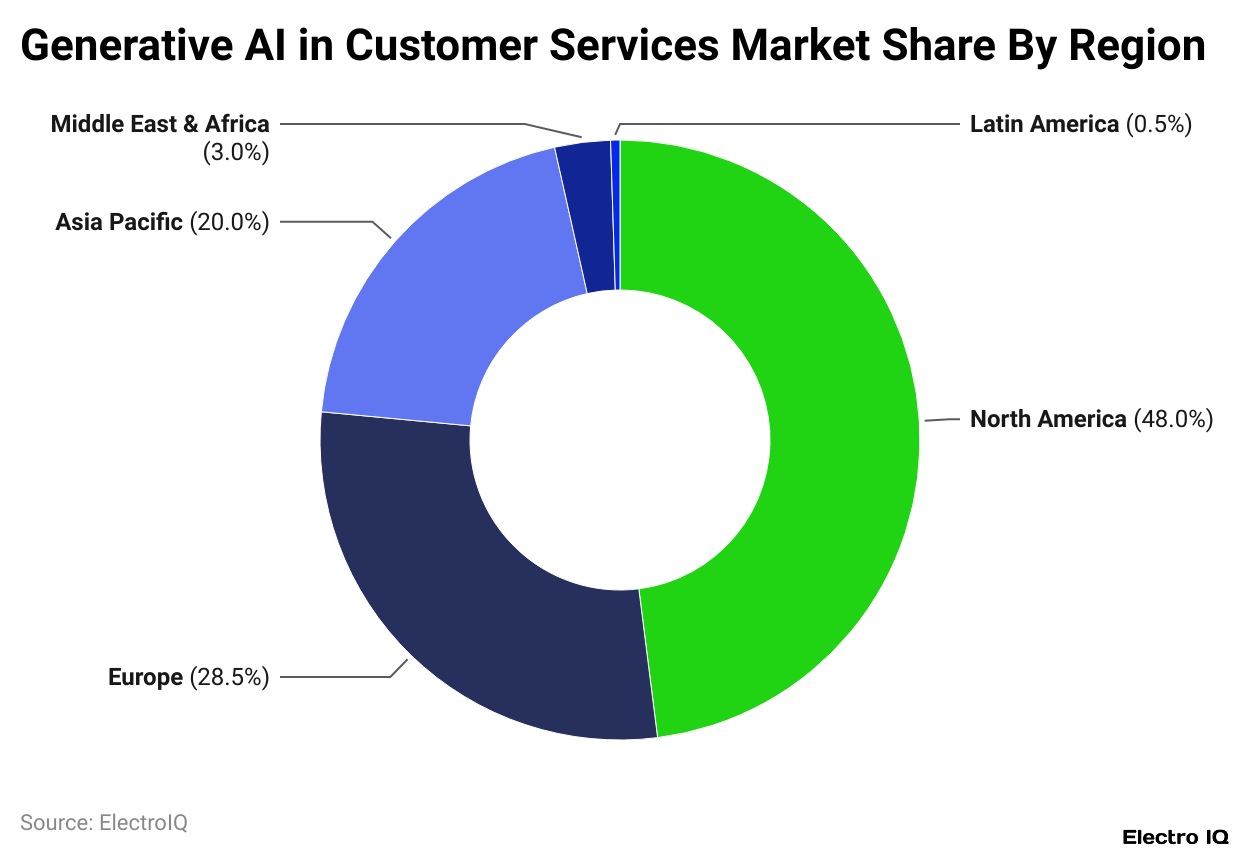
(Reference: tidio.com)
- North America leads the global AI customer service market with a commanding 48% share, thanks to the widespread acceptance of technology, advanced infrastructure, and the presence of major AI vendors.
- Europe comes second with 29%, owing to strong investments being made in automation and digital transformation across sectors such as finance, retail, and telecom.
- Asia Pacific capitalises on 20% of the market at a fast pace of digitalisation in China, India, and Japan.
- On the other hand, the Middle East poses 3%, wherein AI adoption is slow but steady in sectors such as banking and logistics.
- Latin America takes almost 1%, inasmuch as implementation is still at a nascent stage, accompanied by poor infrastructure compared to other regions.
Worldwide Contact Centre and Conversational AI Spending
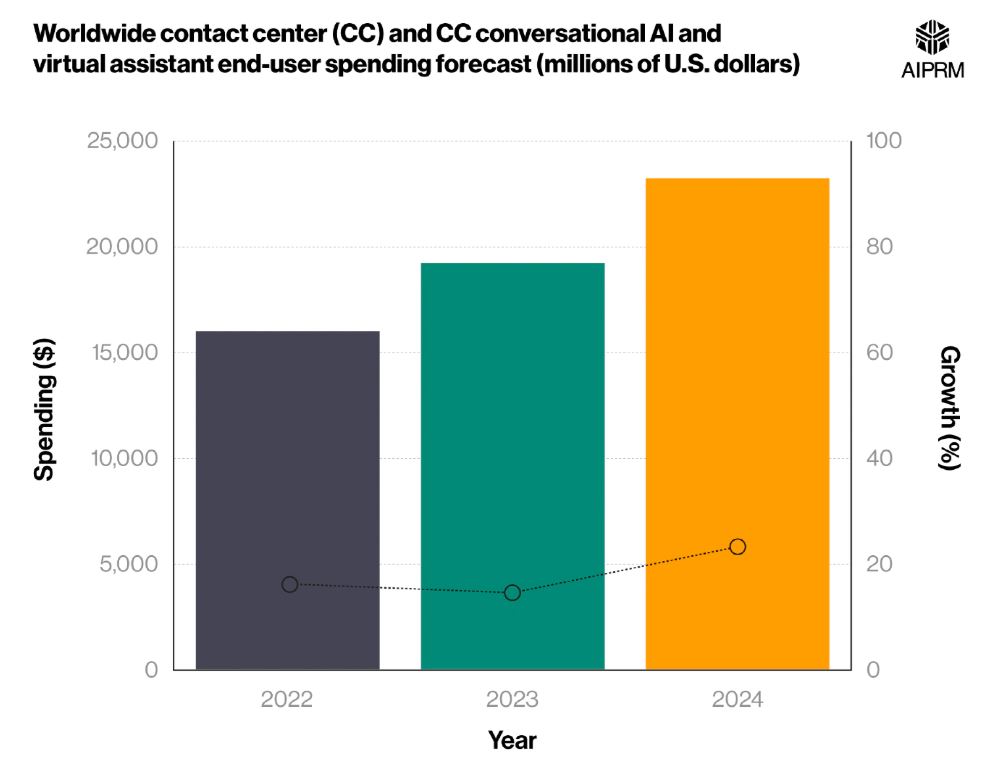
(Source: aiprm.com)
- As per Aiprm, AI customer service statistics show that contact centres all over the world spent upwards of US$16 billion on conversational-AI and virtual-assistant technologies in 2022.
- This large investment reflects an increase in reliance upon AI-based tools to augment customer interactions, decrease operational costs, and increase efficiency.
- The spending will probably witness an increase of almost 24% in merely two years.
- By the year 2024, these centres will probably allocate somewhere near US$23.17 billion to such technologies.
- The trend shows accelerated demand for an AI-based solution that can take in large volumes of customer queries, respond instantaneously, and provide an equally smooth support experience across channels.
Most Common Ways To Use AI In Customer Service
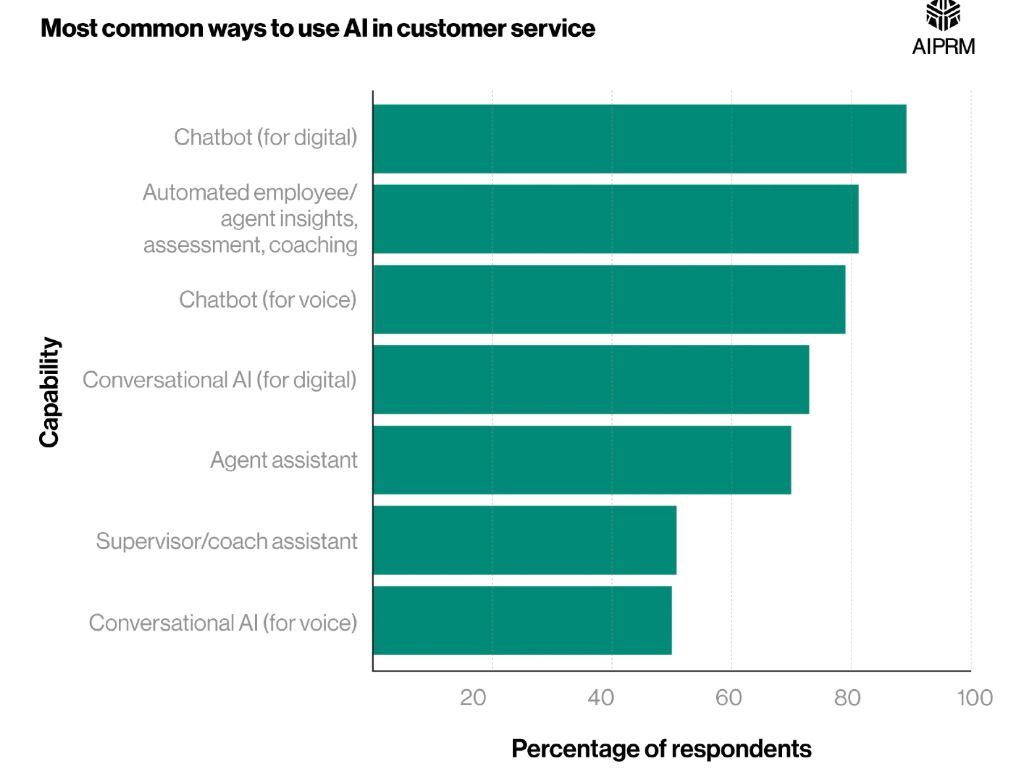
(Source: aiprm.com)
- Making use of AI usually entails having chatbots for customer service through which human-interaction-like conversations are simulated to render quick and straightforward answers to customer queries.
- In fact, 89% of contact centres report AI use for providing service through digital chatbots, making this the most common application of the technology.
- 81% of contact centres reportedly use AI in either staff training or gaining insight into team performance, thereby providing the value of workforce optimisation.
- Another important application is voice chatbots, with 79% of centres applying generative AI for voice interactions, approximately 10 points lower than text-based chatbots’ application.
Benefits Of AI Customer Services
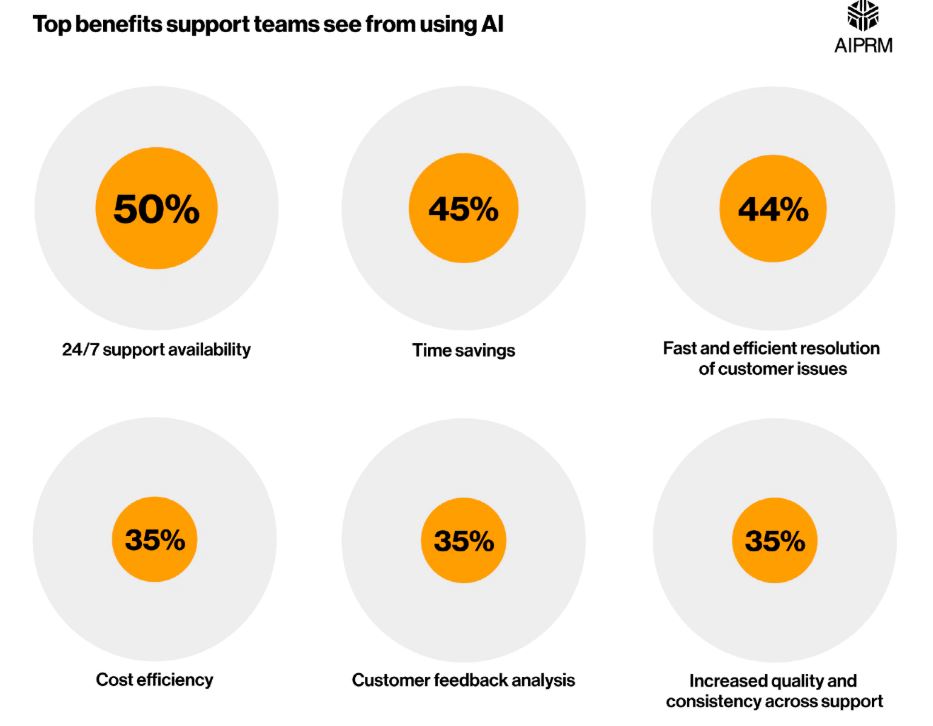
(Source: aiprm.com)
- According to support teams, AI customer service statistics state that the biggest advantage of AI in customer service is 24/7 availability, mentioned by 50% of respondents.
- Constant availability ensures that customers can be assisted at any time, even outside working hours.
- Another advantage, according to 45% of support teams, is that AI saves time for both agents and customers, making interactions quicker and more efficient.
- Next, almost on a par with, 44% of respondents report AI’s ability to enable faster issue resolution.
- Moreover, 35% can report that AI saves money internally and gives the company a better insight into customer feedback.
- Another significant advantage is that it can provide consistency as AI systems perfectly parallel human agents, thus providing a uniform support experience in every single interaction.
Role of AI In Personalising Customer Experiences
- Increasingly, consumers are more open to considering AI as a tool for a variety of services.
- As per SurveyMonkey, AI customer service statistics show that 65% of consumers were comfortable using AI to order food and drinks, while 59% were willing to use it to return purchases.
- McKinsey mentions that companies using AI for personalisation of experiences may attain up to 15% revenue uplift.
- AI is also shaping up to be a formidable friend of support teams.
- In a 2019 study on arXiv, it stated that customer service agents gave positive reviews to AI tools almost 80% of the time, testifying to how AI has positively assisted in making the work that much better and more effective.
- Yum Brands says it saw increased purchases and reduced customer churn from the AI-powered marketing campaigns, proving how personalisation helps with customer retention. Companies will invest more in AI as time goes by.
- According to Zendesk, around 64% of customer experience leaders plan to increase their development spend on chatbots within the upcoming year, indicating a solid commitment to upgrading AI capabilities in customer service.
AI Improves Customer Service Efficiency And Productivity
- Integrating AI into customer service enables them to be more efficient and save costs.
- With AI in use, response times to first inquiries are down by about 37% when compared with those without any form of automation.
- A notable example is AkzoNobel, which installed AI solutions that cut down on average response times from about six hours to 70 minutes.
- During peak seasons, AI chatbots reduce the need for staff by up to 68%, and through the rest of the year, in addition to lowering operational strains, they reduce the need for staff by 51%.
- Additionally, AI-enabled companies close tickets 52% faster than those without such technologies implemented.
- Unity is a real-life example-it implemented an AI agent to assist its team and dealt with 8,000 fewer tickets, saving US$1.3 million.
- When talking about the current perspective of conversational AI in contact centres, it is said that the technology will save US$80 billion in labor costs by the year 2026.
- Generally, AI adoption corresponds to a 35% reduction in customer service costs and a 32% revenue increase.
- The study by KPMG shows that companies, on average, make US$3.50 back in revenue for every dollar spent in AI, with 5% of companies reporting even greater returns of US$8.
- AI tools make the buying experience smoother and drop customer service expenses by 30%.
- Agents equipped with AI can resolve 13.8% more customer incidents in an hour, thus increasing productivity.
- A Deloitte report states that another aspect where AI helps is preventing information overload in agents, so they are 35% less likely to feel overwhelmed during calls.
- Automatically classifying service issues and routing customer contacts using AI speeds up contact centre worker productivity by 1.2 hours daily.
- Additionally, AI-based customer service teams reduce call handling time by 45%, resolve customer issues 44% faster, and achieve a 35% improvement in support quality and consistency.
AI Customer Service Statistics Across Industries
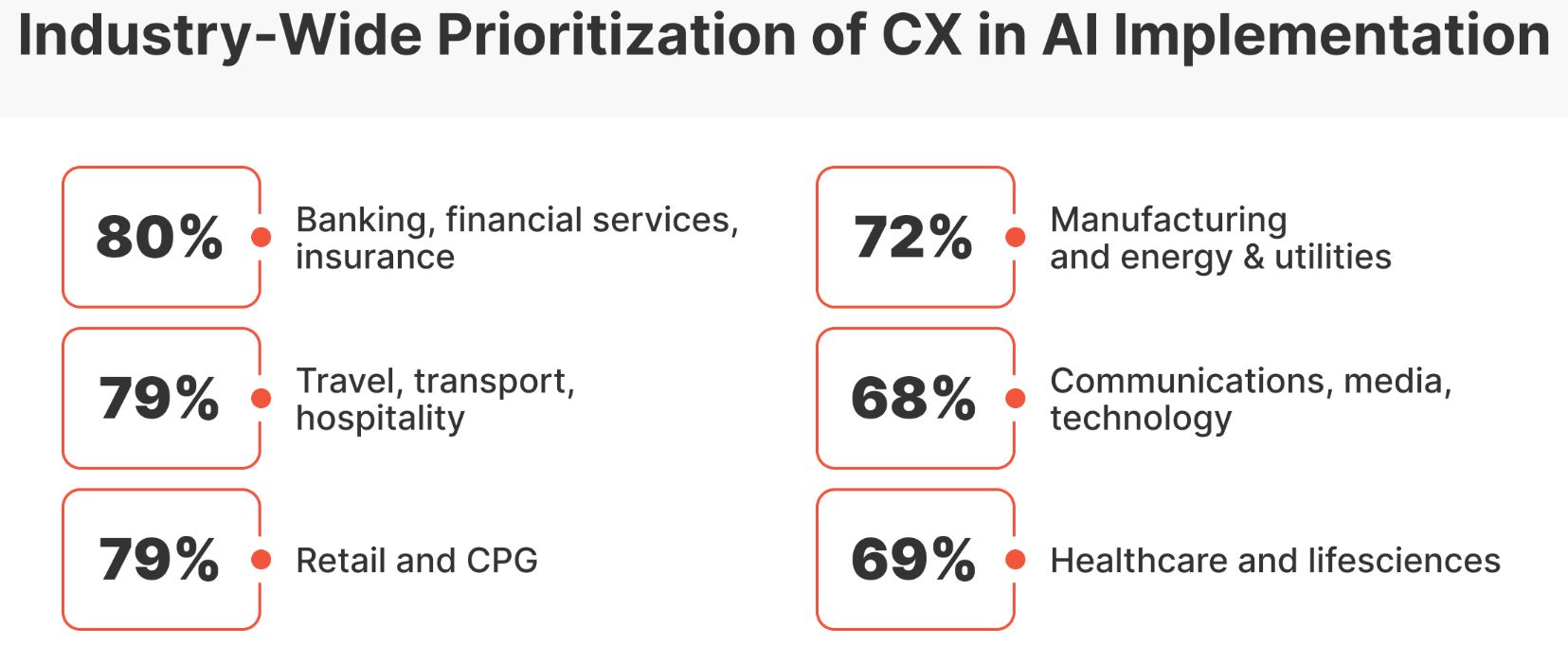
(Source: masterofcode.com)
- In retail, 63% of retailers already use AI to enhance customer interaction, while 40% have dedicated teams and budgets set up for AI development.
- From the consumers’ perspective, price-sensitive shopping support seems to be the most valued benefit of AI, with 28% naming it as a major application in view of worldwide cost-of-living issues.
- Additional areas of interest include loyalty and personalised rewards (23%), online product discovery (23%), item validation (19%), and AI recommendations (19%).
- Transparency remains important: A majority of 57% of shoppers feel comfortable with AI in e-commerce if the businesses acknowledge using it.
- In addition, 73% of consumers expect brands to know their distinctive preferences, and AI agents provide the means for retailers to ensure such personalised engagement.
- On the other hand, the banking and finance sector states that 46% of financial institutions using AI observed an improvement in customer experience.
- Forecasting ahead, 79.5% are expected to increase investments in customer experience technology.
- Their attention is largely on improving digital services (58.5%) while supporting self-service for both basic needs (47%) and complex needs (42%).
- Potentially, companies want to build future investments in analysing contact centre data (82.5%), chatbot optimisation (72.5%), and virtual assistant deployment for self-service support (65.5%).
- In 2023 alone, the industry put US$35 billion into AI, and projections say this could grow to US$97 billion in 2027, so there is an impressive eye on an AI transformation.
- In healthcare, according to a Deloitte report, more than 70% of patients believe AI can change the delivery and quality of care.
- Many already use AI for health and wellness applications: 19% use it to learn about medical conditions; 16%, to understand treatment options; 15%, to interpret complex medical language and for improving well-being.
- Trust in AI is also quite high: 69% of those who use it rated the information it provided as very or extremely reliable.
- Additionally, 75% of top healthcare organisations are either currently working with generative AI or intend to scale its use across their operations.
- In the telecom field, 97% of communications service providers claim that conversational AI positively affects customer satisfaction.
- After realising the advantages of AI in customer experiences, 91% of telecom executives are contemplating the implementation of digitised and automated workflows by 2026.
- AI-based chatbots have served 82% of customers in accessing services without long wait times.
- According to Haptik, more customers are opting for self-service tools, with 56% choosing plans and 77% paying bills and recharging via such tools.
- In telecom, there is a 5 to 15% increase in revenue associated with personalised AI experiences, while in automation, AI brings a 30% reduction in operation costs, thus promising better service and ambience.
Business Leaders’ Support For AI In Customer Service
- Awareness about the potential benefits of AI for customer service is growing among businesses.
- As per Zendesk, AI customer service statistics indicate that about two-thirds of business leaders felt strongly about the effectiveness of AI investment in customer support.
- This confidence is reflected in plans, as nearly 80% of customer service leaders intend to increase investments in AI over the next two years, according to Deloitte Digital.
- Improving the customer experience is also considered paramount, with 72% of business leaders citing AI integration as an important goal for the current year, according to Zendesk.
- Trust is yet another important factor; 58% of leaders surveyed by Intercom trust that AI used in support roles builds trust with the customers.
- Cost savings are yet one more incentive: 60% of support leaders surveyed by Intercom anticipate lowering expenses related to support within the next five years through AI.
- KlausApp further reveals that investing in AI and automation for customer service is planned by 70% of organisations within the next year.
- Furthermore, the popularity of the likes of ChatGPT is powering decision-making: 55% of support leaders say ChatGPT has made them more likely to invest in AI during the year, based on Intercom findings.
- These statistics demonstrate the strength and growth in commitment by the business leaders in leveraging AI for smarter and cost-efficient customer service.
Customer Perceptions And Trust In AI-Powered Customer Service
- Survey data demonstrate that, while AI keeps transforming the customer service space, the bulk of consumers continue to disfavour the complete replacement of human agents.
- SurveyMonkey’s Curiosity at Work survey reveals almost universal preference for human interaction, as 90% of respondents favour human intervention over that of chatbots.
- The prime reasons AI customers cite for choosing it over humans are clear-cut advantages of less after-hours call demand (41%) and quicker problem resolution (37%-speed being quicker resolution of customer issues).
- In simple terms, empathy and understanding of fellow human beings matter to customers. Customer satisfaction rates paint the same picture of preference.
- The Net Promoter Score (NPS), one of the most common measures applied to indicators relating to customer loyalty or customer satisfaction, has averaged 72 points higher for human agents than AI chatbots.
- Among those under 34, 41% express negative sentiments toward the use of AI in customer experience, whereas this number shoots up to 72% in the older age group, i.e., 65 years and above.
- Even with these differing attitudes, AI awareness remains somewhat low among customers.
- A mere 18% of respondents feel very confident that they can identify when they are dealing with a chatbot, and only 14% can confidently distinguish between AI-generated content.
- Less than 48% of people believe they can accurately identify AI-based responses, suggesting that there might be a perception gap when it comes to recognising AI responses in real-world situations.
Customer Opinion On AI Agents
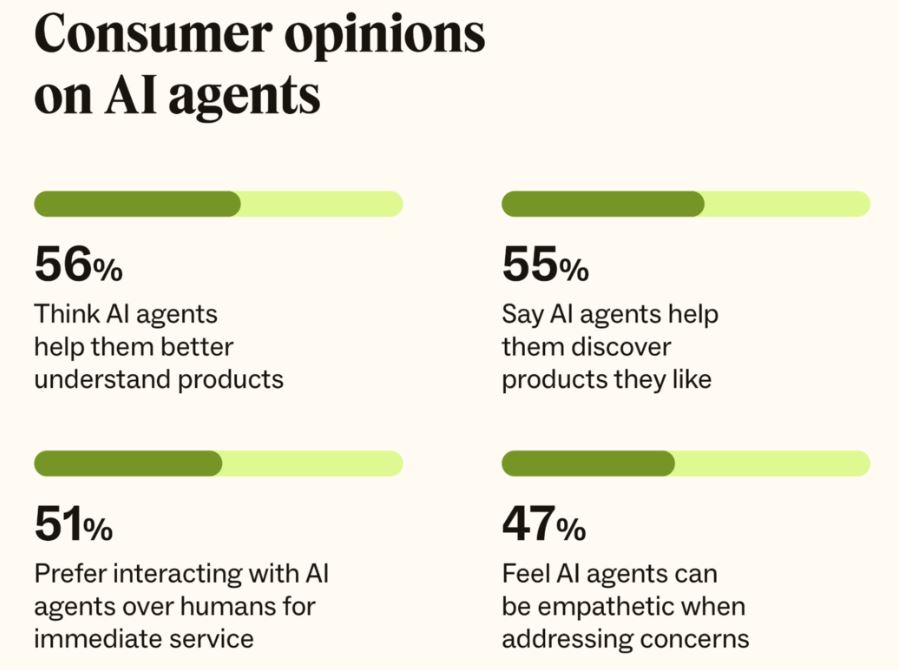
(Source: zendesk.com)
- More than 51% of consumers now state they would rather interact with bots than human agents, provided the need for instant response is there, marking the shift in preference for speed and efficiency.
- While this trend has evolved, 58% of CX leaders also believe that their chatbots will grow more sophisticated through 2024 to acquire growing capabilities that align more with customer demands.
- Shortly, meanwhile, 56% of customers predict bots will be capable of carrying natural conversations as human agents can by 2026.
- Interestingly, 68% of consumers already expect chatbots to uphold the same level of knowledge and facility as expert human support agents, indicating a rise in customer expectations with maturing AI technology.
- 64% of CX leaders are planning to increase investment to update and improve their chatbot systems within the next year.
- Customer behaviour is changing, too, given that 67% are now putting a wider set of questions to chatbots, an indicator of increasing confidence in AI’s ability to deal with complex or eclectic queries. There is another rather interesting emotional side to this situation.
- 67% of CX leaders believe that AI-based bots would further bond customers emotionally and begin to blur the lines between plain task-based automation and service provided by a human touch.
- Lastly, 48% of customers say it is increasingly getting harder to distinguish between bots and human agents, hinting at conversational AI getting better and better at imitating real human interaction.
Impact of AI-Based Applications In Contact Centres
- AI applications are successful in contact centres, with 91% of companies satisfied with their results.
- Over half (56%) of the customer support teams are now more optimistic than last year, with the prospects of AI increasing their success at work.
- Advantages to such implementations of AI include customer service (69%), reduced waiting times (55%), and streamlined workflows (54%).
- Furthermore, 48% of organisations perceive improved customer satisfaction, and 41% have cited better use of data and analytics.
- Conversational AI and chatbots are among the major drivers of productivity.
- An overwhelming 94% of customer service professionals attest to such tools augmenting their productivity, whereas 92% saw faster resolution of customer issues with them.
- Also, 87% of agents confirmed less effort while addressing support queries.
- From the efficiency gains, cost reductions started flowing in, with 65% of the teams agreeing that AI helped reduce costs, and 53% reporting decreases in other operational costs.
- The most common implementation under AI application, following agent assist, is undertaken by 40% of the support units. This tool alone reduces average handle time by 27%.
- 34% of businesses tracking AI effectiveness say AI helps revenue increase, 40% cite better customer ratings, and 32% say it improves team productivity.
- Ensuring human agents work alongside virtual assistants also seems to result in 7.7% more simultaneous chats, thereby improving workload capacity.
- From a financial standpoint, hybrid implementations come with substantial benefits of about US$4.3 million saved in staffing costs.
Concerns And Challenges Of Using AI In Customer Service
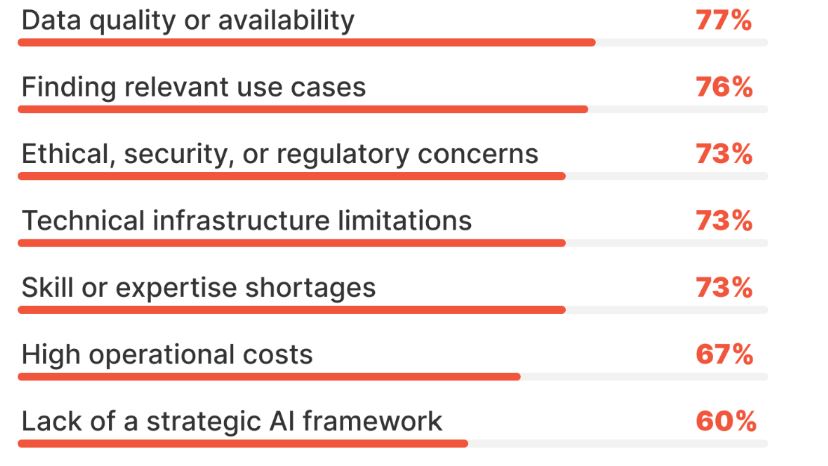
(Source: aiprm.com)
- Various challenges arise for implementing AI in customer service, especially regarding data.
- More than 77% of companies report that limited availability and quality of data needed to develop efficient AI solutions stand as a major blocker in their adoption.
- Another common problem faced is finding practical but relevant use cases; roughly 76% of customer service teams face this kind of uncertainty when trying to determine precisely how AI can be used effectively in their customer service operations.
- Besides these technical challenges stand the more general concerns: 73% of companies cite being worried by AI use in any capacity in their business application from ethical and security viewpoints.
- These factors together make the path to AI adoption more complex for many organisations.
- One of the biggest challenges businesses face when implementing AI in customer service is maintaining a personalised experience, with 45% of respondents citing this as a concern.
- Additionally, 40% point to occasional inaccuracies in AI tool outputs, which can negatively affect the customer experience.
- Another 32% report difficulty in integrating AI tools with their existing systems and data, making adoption more complex and resource-intensive.
- From both the consumer and support specialist perspectives, hesitation around AI use in customer service is also common.
- About 44% of customers still prefer interacting with human agents over AI, and 36% say AI interactions feel less personal.
- On the business side, 30% of enterprises worry about becoming overly dependent on AI technology, while 23% are concerned about the associated costs.
- Additionally, 39% of customer service professionals fear that AI could replace their jobs shortly.
- Confidence in AI’s accuracy is also mixed—55% of support teams believe tools like ChatGPT can provide incorrect information, and only 42% feel confident in their ability to detect these mistakes, often referred to as “hallucinations.”
- Transparency around the use of AI is seen as critical by both businesses and consumers.
- More than 90% agree that companies should disclose when AI is being used in customer support.
- 77% of businesses and 73% of consumers believe that human oversight of AI systems is necessary, and shoppers are more likely to buy from companies that ensure proper monitoring of AI use.
- This underscores the importance of both trust and ethical responsibility in the deployment of AI in customer service settings.
- Both businesses and customers regard transparency about AI usage as very important.
- More than 90% support explicit disclosures from companies when AI is implemented in customer support systems.
- About 77% of businesses and 73% of consumers say human oversight should be applied to AI systems, and consumers are more willing to buy from companies that ensure such oversight of AI use.
- This speaks to the trust factor and ethical responsibility that come into play when AI is deployed in a customer service setting.
Future Use of AI In Customer Service
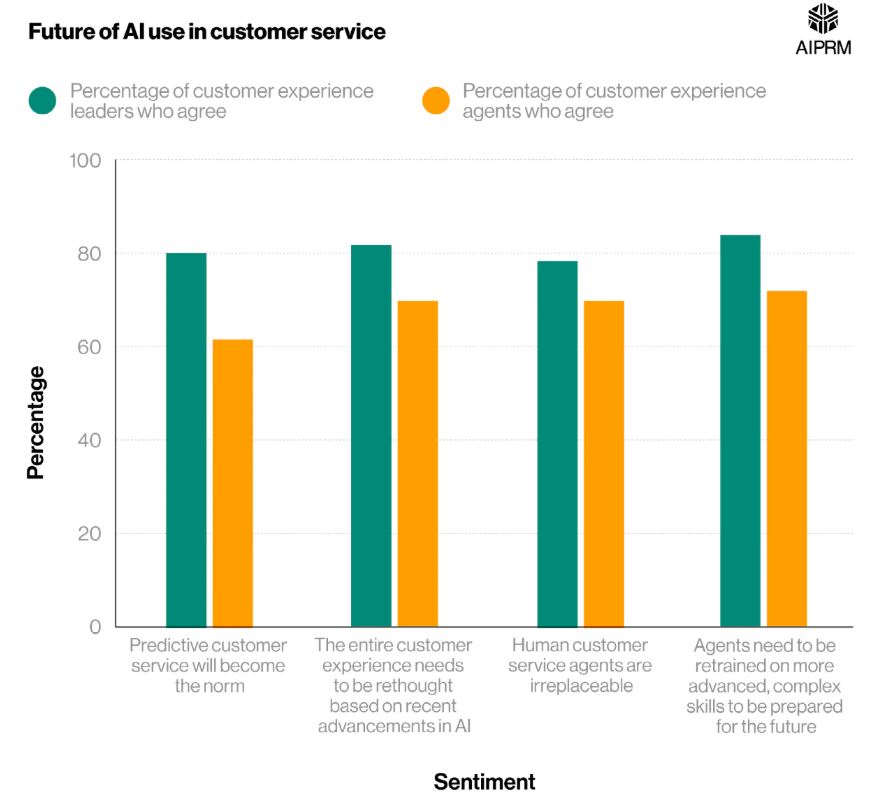
(Source: aiprm.com)
- Gartner expects that conversational AI’s entry into the fold of customer services will herald a significant cut in call centre labour expenses, amounting to potential savings of US$80 billion by 2026.
- Generally speaking, CX leaders are upbeat about the future of AI, with 80% expecting predictive customer service, where AI predicts and resolves problems ahead of time, to be a common practice.
- By contrast, only some 62% of customer service agents enjoy that level of confidence in AI future capabilities.
- Although CX-laureates envisage a strenuous position for AI, most across this domain think that human agents remain vital.
- 78% of CX leaders affirm human service agents as irreplaceable, which is unlike the 69% of agents showing such conviction, perhaps implying agents themselves are more uncertain about their job security in the revelations of AI.
- A high percentage of CX leaders, i.e., 84%, maintain that human agents will not be replaced but soon will require retraining to acquire more complex skills needed to work alongside AI tools.
- The above facts clearly describe a future setup where AI will augment human jobs in customer service, rather than replace them.
Conclusion
AI customer service statistics: The AI for customer service is no longer a trend-it is a necessity. Creating increased performance and customer satisfaction, businesses in various industries are employing AI, from chatbots, voice assistants, and recommendations to agent-assist tools.
However, challenges like trust, data quality, and maintaining human connection arise. The next area of focus will be the ethical, transparent, and human-centred application, balancing automation with empathy as the capabilities increase.
FAQ.
The generative AI market in customer service is exploding-the revenues stood at US$308.4 million in 2022 and are forecast to jump to US$482.72 million in 2024. It will easily cross the US$2.8-billion pathway by 2032, which reflects that strong long-term growth will be driven by more and more businesses adopting generative AI for enhancing support efficiency and lowering costs.
Mainly, AI is used to power chatbots, with 89% of contact centres rolling them out for brief customer interactions. Then, 81% deploy AI for internal training and performance insight, while 79% rely on AI-powered voice assistants, indicating many of these technologies are used beyond the customer-facing context.
AI lends perfect assistance to enable 24/7 hours of service, it causes a reduction in response time by 37%, and it causes faster ticket resolutions by 52%. They help reduce the number of agents during peak periods by 68%, allow costs to be lowered by up to 35%, and bring in aspects of customisation, efficiency, and steadiness in customer communication.
In different industries, AI is implemented to improve customer service. In the retail industry, 63% of companies use AI to improve customer interaction and issue personalised rewards. In the banking industry, 46% say that AI improves customer experience, with US$35B going into AI in 2023. The healthcare industry holds a docket of 70% or over in patient support to deliver better care with AI. 97% of operators of telecommunications are in a unanimous move to declare that AI enhances customer satisfaction, with AI chatbots cutting down cost and wait times by 30%.
51% of customers admit to preferring bots only for the immediate responses they provide, 67% would sometimes ask chatbots more complex questions, while a strong majority (90%) would prefer human intervention for empathy and clarity. Age matters-a younger set appears to be open to AI, while the older tend to put less stock in it. Most people are unable to detect or respond with AI, with less than half feeling certain about recognising a chatbot interaction.
The major challenges are poor quality of data (77%), inability to identify AI use cases (76%), and ethical or security concerns (73%). There is doubt about personalisation as well, with 40% of teams reporting the rare instance when AI gets it wrong. There are additional integration concerns about melding with existing systems and staying within budgets. Plus, 39% of support workers are afraid of losing their jobs, while transparency is a must: over 90% of users want to be told when they are dealing with AI.

Maitrayee Dey has a background in Electrical Engineering and has worked in various technical roles before transitioning to writing. Specializing in technology and Artificial Intelligence, she has served as an Academic Research Analyst and Freelance Writer, particularly focusing on education and healthcare in Australia. Maitrayee's lifelong passions for writing and painting led her to pursue a full-time writing career. She is also the creator of a cooking YouTube channel, where she shares her culinary adventures. At Smartphone Thoughts, Maitrayee brings her expertise in technology to provide in-depth smartphone reviews and app-related statistics, making complex topics easy to understand for all readers.








